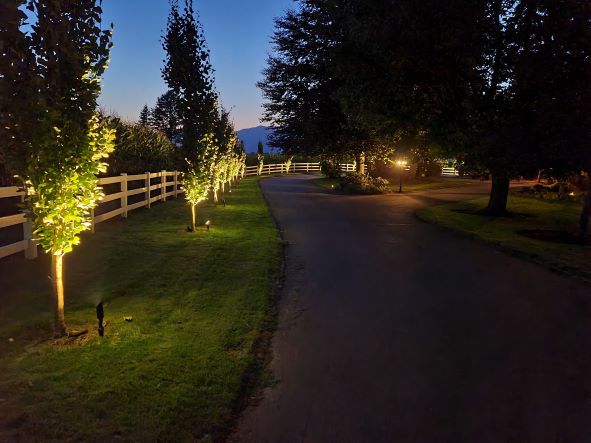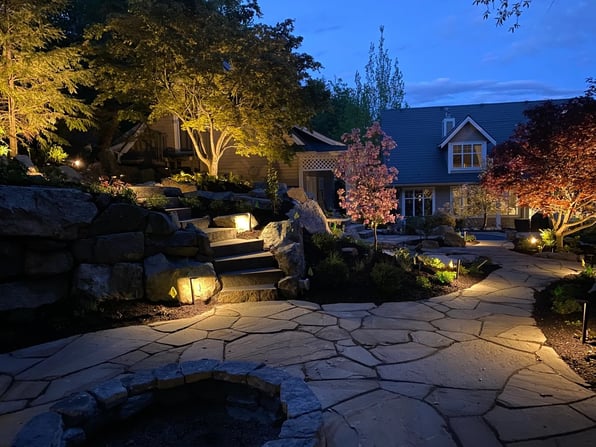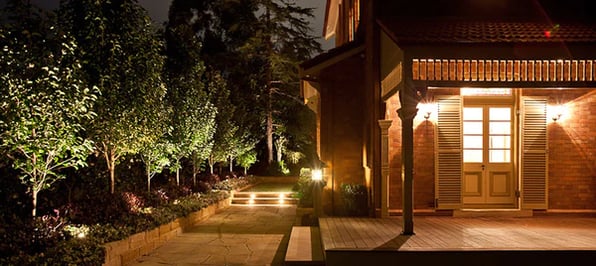
5 min read
Pros and Cons of Solar and Low Voltage Lighting Systems
Posted by The Illuminator
Dreaming of landscape lights but don’t know what system is right for you? We’ve got your back. Keep reading to learn more about the pros and cons of the two most popular types of landscape lighting.
Pros of Solar Lighting
1: No wiring is needed!
Solar lights are amazing if you’re looking for something quick and easy to install by yourself in literally seconds. Simply place the fixture on/in whatever surface it is to be mounted to (wood, dirt, etc.) and it’ll start doing its thing! No wires, no tools, and no time commitment.
2: They’re Cheap
Solar lights are the cheapest option by far. You can find these lights at big box stores and even dollar stores for just a couple of bucks per fixture. You’re also saving money on equipment as you don’t need to purchase wiring, tools, or a transformer, and you don’t need to hire a professional for installation. Not only cheap upfront, but these lights also cost nothing to power as all of their energy is provided by the sun!
3: Eco Friendly
As with most solar-powered equipment, solar lights are eco-friendly to power. Though not all solar lights are made with eco-friendly materials, solar energy is inexhaustible and renewable, making it a great way to power your outdoor lighting
Cons of Solar Lighting
1: Can’t be placed undercover
If you’re looking to light the underneath of a massive tree or the inside of a gazebo, solar lights are not the best option. As these lights get their energy from the sun, they need to be in a location that gets enough natural sunlight to keep them running.
2: Need Regular Maintenance/Cleaning
As with all things outdoors, landscape lights tend to get a little dirty. This is usually more than okay, except when it comes to solar lights. A dirty solar panel can prevent the battery from charging and it won't be able to turn on.
3: (Lack of) Brightness
Solar lighting is not known for its wow factor or brightness. Expect a subtle, “bright-white” colored light that will likely dim in the winter months as they get less sunlight.
4: Replacement Costs and Waste
While cheap upfront, solar lights can be more expensive in the long term. During darker seasons, solar batteries aren’t able to get a full charge, causing permanent damage that often can't be repaired. Some higher-end solar lights may have a replacement battery option available, but this is not the case for most.
With all the tossing out and replacing, solar lights end up creating more costs, time, and waste.
Pros of Low Voltage Lighting
1: Potential for a DIY Project
Low voltage lights do not need to be installed by a professional and can be installed safely by almost anyone with basic knowledge of electricity, or after watching a quick tutorial on safe lighting installation.
2: Extremely Safe
Low voltage lighting systems are very safe to work with, with almost no risk of electrical shock, though minor burns are possible if incorrectly handled. Because of the ultra-low voltage of a 12v system, water exposure isn’t a threat to anybody’s safety and will, worst-case scenario, cause the light fixture to stop working if exposed to too much water.
3: Cost and Energy Efficient
Expensive upfront? Potentially. But, overall, low-voltage lighting is the most cost-effective system to acquire and maintain.
Initial costs of supplies, tools, fixtures, transformers, and installation (if professionally installed) can seem intimidating at first, but keep in mind most low-voltage lights can have a warranty period of anywhere from 1 - 15 years. These lights are usually serviceable and repairs can be made outside of the warranty period and bulbs (if not integrated) can be swapped out.
Also note that if purchasing high-quality fixtures and properly taken care of, low voltage lights, (especially LEDs) rarely need maintenance and should only need a bulb change every few years.
Running costs for low voltage lights are also very reasonable, but better yet when using LEDs. The cost of powering a low-voltage LED lighting system varies depending on the total wattage of your system, but you can expect to pay a few extra bucks a year.
4: All of the Options
There are TONS of options when it comes to low-voltage landscape lighting. You’ll easily be able to find the perfect fixture color, light color, size, shape, and style, the possibilities are endless with low-voltage systems. A quick google search can show you hundreds of options and leave you feeling overwhelmed, so we recommend finding a reputable brand that you trust and selecting your favorite of their fixtures.
You can find even more pros to low voltage landscape lights by reading our article Low Voltage Lighting - What's the Appeal?
Cons of Low Voltage Lighting
1: You’ll need a transformer
Low-voltage lights require the use of a transformer. This can add a little bit of extra cost upfront, but if the transformer purchased is high quality and installed properly, it'll last just as long as your lights (or longer) and save you money in the long run by allowing you to power your energy-efficient, low-voltage lights.
2: Voltage Drop
The voltage drop will not be an issue if the low-voltage lighting system has been properly planned and the voltage drop accounted for. Voltage drop may require extra planning, modifying of plans, or hiring lighting professionals to ensure it will not keep you from having a beautiful yard.
Unsure of what voltage drop is? Voltage drop is the loss of voltage as you go down your run and occurs when too many lights are on a length of wire that is too long. If you're running 20 lights on 300ft of wire, and your transformer is only supplying 12v, you likely won't have enough voltage at the end of your run (farthest from the transformer) to power those tail-end lights. Changes can be made to resolve issues regarding voltage drop, but, you can also predict how many volts you'll lose with this formula:
Watts on run x Length of run in feet ÷ 7500 (for 12 gauge wire)
If you're running 20 of your 3-watt lights on a 300ft run, you'd follow the equation above (60 watts x 300ft = 18,000 ÷ 7500 = 2.4 volts dropped. If your transformer is supplying 12v and you're losing 2.4 volts, you won't have enough voltage to power all the lights on the line. If, however, you use a 14v transformer and lose 2.4v, you'll still have 11.6v, just enough to power all of your lights (a minimum of 11v is needed on 12v lights).
3: Movability
Changing the location of a low-voltage fixture is an inconvenience compared to the ease of moving solar lights. Picking up and plopping a solar light into a new location with no prior planning or time commitment is very attractive. When properly planned and installed, you shouldn’t need to be moving your lighting around anyways, but if it is needed, it can be done safely and efficiently by yourself.
After deciding the best system to suit your needs, do some research on reputable brands to purchase your light fixtures. Typically, the light fixtures found in big box stores and dollar stores aren’t going to last too terribly long but can be a great option for someone looking for an easy and budget-friendly project.



